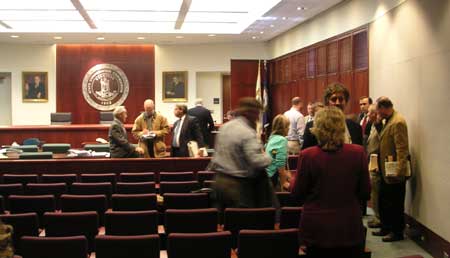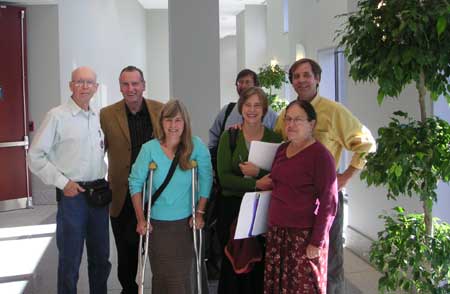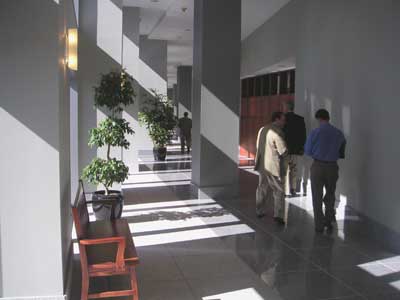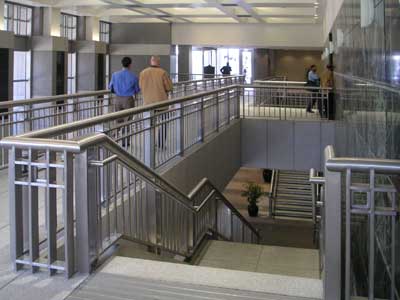State Corporation Commission of Virginia:
Hearings relating to Wind Energy in Highland County
30 October – 16 November 2006
Last Update: 22 November 2006
Highland New Wind Development — permit appliction with the State Corporation Commission, case no PUE-2005-00101.
Final SCC hearings set for Richmond in October

|
|
The SCC courtroom during a break. All photos by John Sweet.
|

|
|
Part of the Highland County contingent in the hallway outside of the courtroom.
John Sweet, Ken Schaal, Patti Reum, Tom Brody (in back), Lucile Miller,
Sandy Hevener and Ches Goodall (in back at right).
|
Highland New Wind Development filed its permit appliction with the SCC on 8 November 2005. The SCC held hearings in Monterey in March 2006. The final round of hearings opened at 10 a.m. on 30 October in the SCC office building, 1300 East Main Street in downtown Richmond, Courtroom C on the second floor. It is expected to continue into November. The main purpose of this hearing is to cross examine expert witnesses who have presented testimony on both sides. However, public witnesses will be allowed to speak at the beginning of the hearing.
Final SCC Hearings — Day One, 30 October 2006
The first day of hearings on the HNWD project is over. Testimony began about 10 a.m. and lasted until after 6 p.m. with a break for lunch. I attended most of this session and spoke on the impact of the project on tourism and scenic views. My complete statement is available but please beware — it is a huge file, 7.8 MB, because of three detailed topographic maps. An abridged version, without the maps, is only 680 KB and should be sufficient for most people wishing to review this material.
The hearing opened with statements from each of the several attorneys involved, which took about an hour. I thought they would then go to the public witnesses, the term for members of the general public who are not parties to the case. Not to be. The first person called was Sen. Frank Wagner from Virginia Beach, sponsor of SB 262, the Virginia Energy Plan. He is promoting renewable energy and Renewable Portfolio Standards legislation for Virginia. He favors wind energy and does not seem to be concerned about its unintended consequences.
Alexander Skirpan, the hearing examiner, then called several representatives of government agencies, who had reviewed the application, for cross examination. Richard Reynolds of the Department of Game and Inland Fisheries took the greatest time, with numerous questions from John Flora, HNWD attorney, as well as others. I did not take extensive notes and will rely on The Recorder to flesh out this report. A break for lunch was called during Reynolds’ testimony and he continued for over a half-hour afterward.
One public witness, Dr. Dudley Rochester of Charlottesville, was called after Reynolds testimony concluded. He is concerned about ozone and fine particulate matter in the air and feels that the proposed project will reduce those pollutants. Wiley Mitchell, attorney for The Nature Conservancy, asked him if he was aware that none of the power generated was slated to be sold in Virginia and pointed out that there would be no clean-air benefit to Virginia from the project.
Dr. Sarah Mabey, biology professor at Sweet Briar College, had given testimony on avian issues and was called next for cross examination, I believe because of a scheduling conflict. They did not get back to the public witnesses until 3:30, when Patti Reum was called. She spoke about updates on birds since the March hearings and summarized the season’s patrons of the Bear Mountain Retreat. Two bald eagle nests were discovered and a hawk watch was established, among other things. Unusually high numbers of migrating hawks and eagles per hour were reported compared to other hawk-watch stations. Jim Morris of Blue Grass spoke about “incidental taking” of endangered species, which is almost certain to occur, and pointed out that killing even one individual is a violation of federal law unless a permit has been issued. Gail Price of Frankliin, WV, spoke about the impact of tourism on Highland County and the importance of the Staunton-Parkersburg Turnpike and Camp Allegheny. She also read portions of a field trip guide to wind turbines in California, which pointed out numerous damaged and derelict turbines.
Sandy Spencer spoke for the Virginia Society of Ornithology and Al Warfield for the Richmond Audubon Society, who also presented a CD video called Rough Wind. Catharine Gilliam of the National Parks and Conservation Association and Elizabeth Merritt of the National Trust for Historic Preservation spoke on historic resources, particularly Camp Allegheny. Eugenia Anderson-Ellis from Scenic Virginia pointed out that wind technology is still evolving so it would be foolish to rush into it and install turbines that will soon be obsolete. Denmark and Great Britain are having second thoughts about their wind plants, she reported. There is a recent report on wind power in Denmark and Scotland posted on National Wind Watch.
Only two people spoke in favor of the project. Kevin Lynch, a Charlottesville City Councilman, wants that city to purchase wind power to operate all city offices and services. He expects this to reduce regional air pollution. He reiterated the discredited notion that a single turbine will serve 1000 homes. David Smith of McDowell presented his usual misstatements about energy, taxes, and jobs. One of the attorneys called him on the tax issue and we all know there are at most two jobs created by this project.
Sandy Hevener of Blue Grass spoke about the eagle survey that has been on-going since spring and showed a map of eagle sightings in Highland. 678 total sightings were reported, including 103 sightings of golden eagles. She had an extended exchange with Brian Brake, one of the HNWD attorneys, as he tried to word a question that would clarify Sandy’s report to his satisfaction. Finally, I got to give my report. As I was packing up to leave, Rick Lambert, well known Highland County cave explorer, was updating his March report on bats. Fitting bats with radio tracking devices has led to better documentation of the large number of bats that roost in the area.
Fran Davenport said that Randy Richardson and Elana Brody wrapped up the day. Randy spoke about problems with wind-power development in other countries. Elana basically conveyed that she would like her generation to be able to enjoy the area and she would like research done so that a major mistake was not made by putting up the wind project only to discover later that it should not have been done. I believe her words were close to, “Don’t crack your skull on the bottom of the pool. We don’t want to have to pick up the pieces.” That’s very loosely quoted.
A brief report on today’s hearing appeared in The Richmond Times-Dispatch and is posted on National Wind Watch. There is a somewhat longer article in The Roanoke Times.
For more detailed coverage of this hearing please refer to the report in The Recorder.
Final SCC Hearings — Day Two, 31 October 2006
I was not present for the second day of hearings but Larry Held sent the following report. “The second day began with public witnesses again. Lucile Miller gave a great report on bats. Most importantly, she spoke of the usefulness of all bats, not just the endangered species. The public hearing was closed after Lucile’s testimony and the SCC began hearing HNWD’s witnesses. The first to testify was Jeffrey Paulson, the lawyer who is going to be procuring investors, working out contracts for delivery of the turbines, etc. He was very interesting, but I would have a difficult time summarizing the cross-examination. Next was Paul Kerlinger, their bird expert. I think the Highland Citizens’ lawyer [Tony Gambardella] got him to admit that in order to assess whether a bird species can be threatened by kills from wind turbines, you have to look at all the wind developments in a region, not just one at a time. I left during his testimony but he continued for some time.” Thanks for the report Larry.
Fran Davenport and Laurie Berman also sent reports on the Tuesday hearing. The following three paragraphs are largely from Fran with some input from Laurie to fill gaps. I have not tried to attribute each item to its source. Thanks ladies.
Tuesday opened with Don Giecek of Chesapeake Climate Action Network speaking. His main theme was, of course, the need to stop global warming. He was followed by Lucile Miller, who gave an excellent report on the value of bats to humankind. She brought out many of the contributions of bats to society, including being an alternative to chemical pesticides. Her conclusion was quite powerful as she equated bats to the canary in the mine — if the bats start dying out then humankind is going to be in severe trouble. Then came Dr. Richard Sherwin from Christopher Newport. He had submitted a report on the bat studies conducted at the site. Basically, he said Dr. Scott Reynold’s findings were of no use because of the type of study used. It was inconclusive. He felt that until a method was developed to accurately determine the impact that preconstruction studies should not be done.
Jeffrey Paulson, the attorney for HNWD who is setting up its partnering relationships, followed. He was questioned for quite some time on the financial side of the issue. The cost of the project is expected to be between $2.1M and $2.8M per turbine. There were also questions about the 1.9¢/kWh tax credit and how it would be applied but the ramifications of this were not made clear. He said it would be five years until HNWD would maintain the turbines themselves and that the turbine operator could be hundreds of miles away. He was questioned as to whether someone could be on site for emergencies. Hearing Examiner Skirpan on several occasions questioned whether there would be enough money in reserve for the decomissioning of the turbines. It seems that it should be close to the cost for installation, yet county required a bond of only $6000/turbine in its permit.
Dr. Kerlinger, HNWD’s bird expert, took the stand and was questioned for quite some time. One thing that came out was that about 95% of his company’s business comes from the wind industry. He produced his reports after only one site visit. Dr. Edwin Michael, the northern flying squirrel expert, took the stand next. He said they are a real pest in a lot of areas and he did not find any on the site. He did not feel there would be any threat to them by the project. The last witness of the day was Dr. Mitchell Bird from William and Mary. He said from a personal standpoint he would not want to see the project put in but that from a scientific stance he really could not say it would be a negative impact to eagles. He did add to that comment that if one of the known nesting eagles were to happen to be attracted by a carcus near a turbine and as a result be killed, that would kill 25% of the county’s known nesting population.
Final SCC Hearings — Day Three, 1 November 2006
Laurie Berman sent the following information on the third day of the hearings. Richard Reynolds from DGIF, who was cross examined on Monday, was back on the stand again today. A representative of the Department of Environmental Quality spoke about how they collate the info from all the agencies to present to the SCC. He said they will rely on info from DGIF studies and recommendations but he didn’t seem really well informed and couldn’t answer questions well because they basically rely on other agencies to do the work and just forward the reports.
Thomas Huson, an energy specialist, said that the project would make very little usable power and would not in any way solve greenhouse gas issues. He also was able to show that, because it is so small, this project could not help prevent other power plants from being constructed. He gave insight into the fallacy of the green energy credits. He was grilled very hard by HNWD legal staff but his arguments were well founded, full of factual answers and info on how wind energy works and how the grid is organized, as well as how green credits are sold.
Suzanne and John Simmons, New Hampden, spoke about great experiences shared with golden eagles and other birds. Beautifully written testimony. They were allowed to speak in spite of coming in so late in the process.
An SCC staff person reported on how letters and other testimony is accounted for. All letters were counted but then accounted for in two ways. First they are simply tallied pro and con. Then letters from the same address are combined and a second tally made. It seems fair that if one person writes three times that is still one person and should be counted once. It does not seem fair that letters from a husband, wife, adult child, and grandparent should be rolled together just because they live at the same address. They are not taking any special note of form letters that are all from the same source (such as CCAN) but mailed in by different people. These should clearly not carry the same weight as individual letters. We do not have the exact numbers but the letters against outweighed those in favor substantially by either method. Questions from legal counsel pointed out they are not reviewing things very carefully. Examiner Skirpan asked again about reviewing decomissioning costs to make certain there would be enough in reserve but this staffer had not reviewed that info. He was also asked about the DOD report and he said he thought he had come across it but had not heard from them, so it was not included in his accounting.
Lawrence Oliver, an SCC staffer in finance, didn’t expect energy would be sold to customors in Virginia. He used HNWD’s data concerning energy output without further evaluation. Another SCC staffer said there has been no study or evidence of nearby property real estate devaluation so didn’t expect that to be an issue.
Final SCC Hearings — The Last Days, 6 to 16 November 2006
The hearings recessed after the session on 1 November, then resumed on Monday 6 November for one day, then for two more days on 15-16 November. There is a report on the 6 November session in The Recorder, Site plan needed to evaluate wind utility – 10 November 2006. “Witnesses say application lacked specifics; SCC hearings continue another week.”
The hearings finally closed on 16 November. I have not heard from anyone who attended these last days but there was a brief report in The Recorder, Wind project hearings come to a close – 24 November 2006. The hearing examiner will issue his report within 30 days, final briefs will be submitted by both sides, and the case will then go to the commissioners. A decision is expected early in 2007.
Return to the top of this page or go back to the main wind page.





